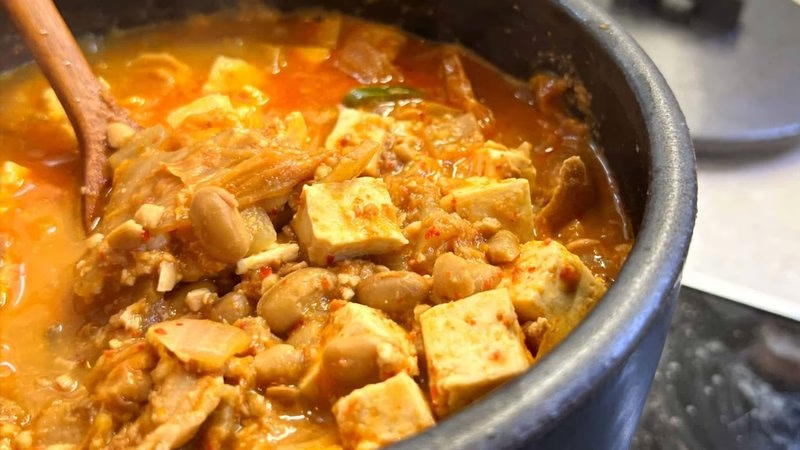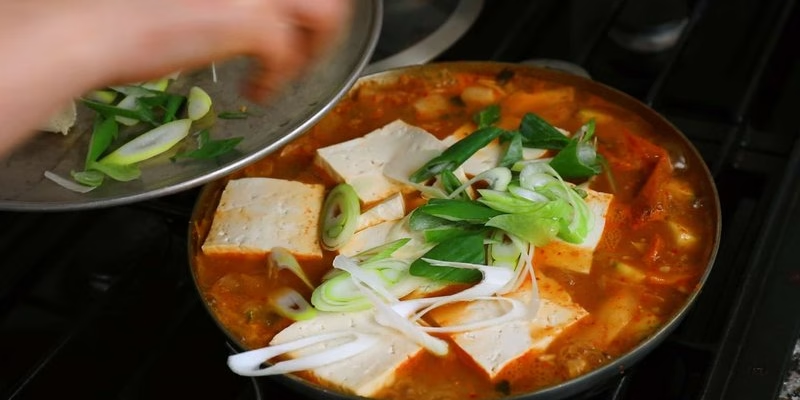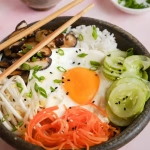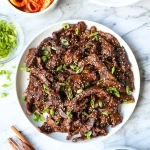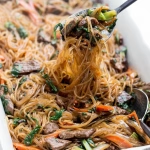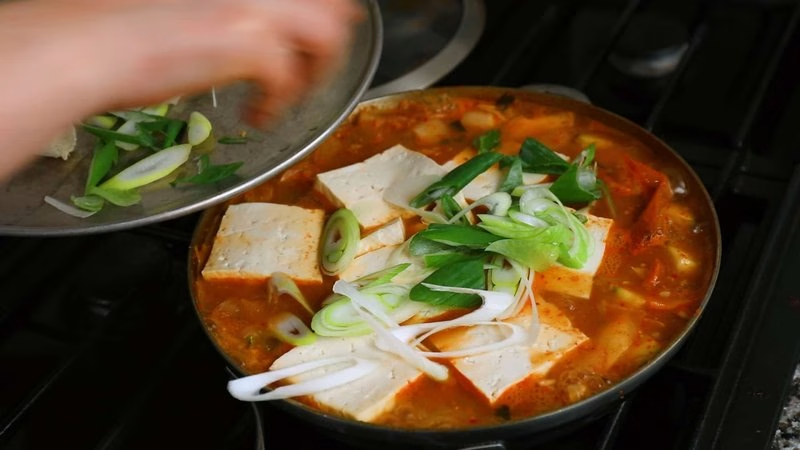
Cheonggukjang Jjigae (Soybean Stew) is a hearty and nutritious Korean dish that’s been adored for generations. Known for its unique flavor and health benefits, this stew brings together the rich, umami notes of fermented soybeans, creating an unparalleled taste experience. Traditional Korean homes often serve this dish to provide warmth and comfort, especially during colder months. Interestingly, Cheonggukjang Jjigae is often considered a quick meal, thanks to its relatively short cooking time compared to other stews.
In this article, you’ll discover how to make Cheonggukjang Jjigae (Soybean Stew) at home, explore its essential ingredients, and learn about variations that can cater to different palates. So, grab your apron, and let’s dive into the world of Cheonggukjang Jjigae (Soybean Stew)!
Ingredients
| Ingredient | Measurement | Description |
| Fermented soybean paste (Cheonggukjang) | 1 cup | *This forms the base of the stew and provides a deep, robust flavor.* |
| Beef (sliced thinly) | 200g | *Adds richness and protein to the Cheonggukjang Jjigae (Soybean Stew).* |
| Tofu (firm) | 150g, cubed | *A great addition for a vegetarian option or extra protein.* |
| Onion | 1 medium, sliced | *Imparts sweetness and complexity to the dish.* |
| Garlic | 4 cloves, minced | *Fresh garlic enhances the aroma and depth of flavor in Cheonggukjang Jjigae (Soybean Stew).* |
| Green onion | 2 stalks, chopped | *Adds freshness and a pop of color.* |
| Vegetable broth | 4 cups | *Use this as the liquid base for a hearty stew.* |
| Red pepper flakes (Gochugaru) | 1-2 tsp | *Adjust to taste for some heat and a beautiful color.* |
| Soy sauce | 1 tbsp | *Enhances the savory quality of the Cheonggukjang Jjigae (Soybean Stew).* |
| Sesame oil | 1 tbsp | *Adds a fragrant finish to the stew.* |
Step-by-Step Instructions
- Prepare the Ingredients: Start by slicing the beef thinly, cubing the tofu, and chopping the onion and green onion. Mince the garlic to release its aromatic oils. Having everything ready makes the cooking process smoother and ensures the flavors blend seamlessly in your Cheonggukjang Jjigae (Soybean Stew).
- Cook the Base: Heat a tablespoon of sesame oil in a large pot over medium heat. Add the sliced onions and minced garlic, sautéing until the onions are translucent and fragrant. This step is crucial as it forms the aromatic base for your Cheonggukjang Jjigae (Soybean Stew).
- Add the Beef: Toss in the thinly sliced beef and sauté for about 3-4 minutes until it starts to brown. This adds depth to the stew, making it hearty and delicious.
- Combine the Ingredients: Now, add the cubed tofu, Cheonggukjang, and vegetable broth to the pot. Stir gently to mix all the ingredients. The fermentation in the Cheonggukjang will infuse the broth with its signature flavor.
- Season the Stew: Sprinkle in the red pepper flakes and soy sauce, adjusting to your heat preference. Let it simmer for about 15-20 minutes. This allows all the flavors to meld beautifully, creating a flavorful Cheonggukjang Jjigae (Soybean Stew) that’s irresistible.
- Finish with Green Onions: Just before serving, stir in the chopped green onions for a fresh touch. This not only enhances the visual appeal but also adds a slight crunch to the stew.
- Serve Hot: Ladle your Cheonggukjang Jjigae (Soybean Stew) into bowls and enjoy it hot. Serve with steamed rice for a complete and satisfying meal that warms your heart and soul.
Pro Tips
- Choose Quality Ingredients: The flavor of Cheonggukjang Jjigae (Soybean Stew) hinges on quality ingredients, especially your fermented soybean paste. Opt for homemade or premium brands for the best taste.
- Customize Your Stew: Feel free to add vegetables like zucchini or mushrooms for more texture and flavor. This enhances your Cheonggukjang Jjigae (Soybean Stew) and makes it even more nutritious.
- Make It Spicy: If you love a kick, increase the amount of red pepper flakes or add some chopped fresh chili peppers while cooking.
- Adjust Consistency: If you prefer a thicker stew, let it simmer longer without a lid to reduce the liquid. Conversely, add more broth if too thick.
- Storage Tips: Cheonggukjang Jjigae (Soybean Stew) can be stored in the fridge for up to three days. Reheat before serving and enjoy the flavors that deepen over time!
Nutritional Information
| Nutrient | Amount per Serving |
| Calories | 270 |
| Protein | 22g |
| Carbohydrates | 20g |
| Saturated Fats | 3g |
| Fiber | 5g |
| Cholesterol | 40mg |
| Sugars | 3g |
| Total Fat | 15g |
FAQs
What is the best way to store Cheonggukjang Jjigae (Soybean Stew)?
Store the stew in an airtight container in the refrigerator for up to three days. Reheat it gently on the stove, adding a splash of water if necessary.
Can Cheonggukjang Jjigae (Soybean Stew) be made vegan or gluten-free?
Absolutely! For a vegan version, omit the beef and use vegetable broth. To make it gluten-free, ensure your soy sauce is labeled as gluten-free, and use gluten-free tofu.
What are the best side dishes to serve with Cheonggukjang Jjigae (Soybean Stew)?
Kimchi, pickled vegetables, or a simple cucumber salad pair exceptionally well with Cheonggukjang Jjigae (Soybean Stew), balancing its rich flavors.
How long does it take to prepare Cheonggukjang Jjigae (Soybean Stew)?
This delightful dish can be prepared in about 30-40 minutes, making it ideal for a quick, nutritious meal any day of the week.
Can I freeze Cheonggukjang Jjigae (Soybean Stew) for later?
Yes, you can freeze Cheonggukjang Jjigae (Soybean Stew) in an airtight container. It can be stored for up to two months. Thaw in the fridge overnight before reheating.
What makes Cheonggukjang Jjigae (Soybean Stew) so special?
The unique fermentation process of the soybean paste gives Cheonggukjang Jjigae (Soybean Stew) its distinctive flavor, rich in probiotics that are beneficial for gut health.
Can I add more vegetables to Cheonggukjang Jjigae (Soybean Stew)?
Definitely! Feel free to include vegetables such as mushrooms, zucchini, or spinach for added nutrition and flavor.
Is Cheonggukjang Jjigae (Soybean Stew) suitable for meal prep?
Yes! It’s perfect for meal prep. Make a big batch, and enjoy it throughout the week; the flavors will intensify as it sits.
In conclusion, Cheonggukjang Jjigae (Soybean Stew) is a fantastic dish to try at home for a satisfying and hearty meal. With its delightful mix of flavors and rich history, it’s not just food—it’s comfort in a bowl! I encourage you to give this recipe a go, tweak it to your taste, and immerse yourself in the wonderful world of Korean cuisine.
Tried this Cheonggukjang Jjigae (Soybean Stew) recipe? We’d love to hear about your experience in the comments below!
